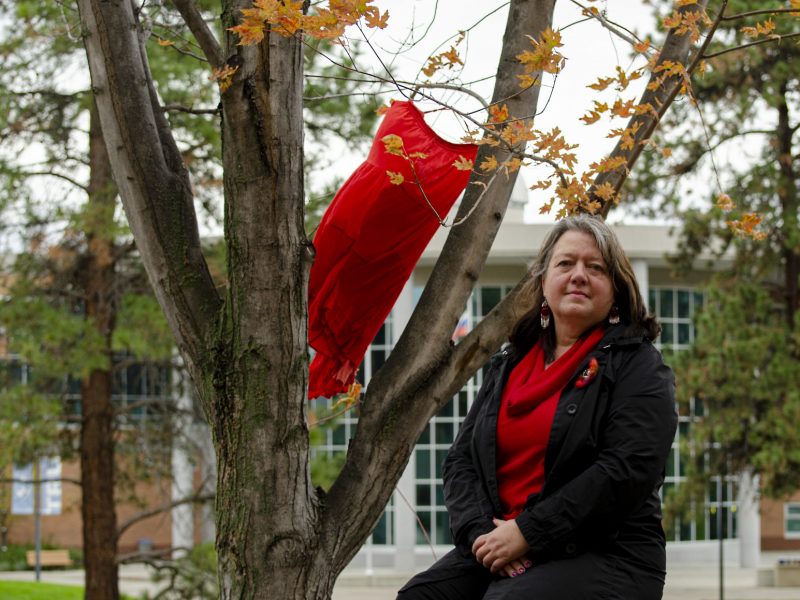
Every October, a number of events take place that bring awareness to the thousands of Missing Murdered Indigenous Women and Girls (MMIWG). October 4 is the day chosen to profile REDress vigils and install red dress displays to honour and remember Indigenous women and girls who are murdered or missing. These events aim to “address” this very important issue in Canada that has long been overlooked.
At TRU, the Office of Indigenous Education and some Indigenous researchers are raising awareness about the Indigenous sisters who are no longer with us but who are alive in people’s hearts and minds. They have hung red dresses around the Campus Commons, in front of several buildings including the Brown Family House of Learning, a building that looks upon the surrounding the hills representing the Tk’emlúps te Secwépemc landscape. Mounts Peter and Paul are in the background and the two walkways represent the meeting of the two rivers (North and South Thompson rivers).
This is a meaningful place to showcase these dresses because it symbolizes Indigenous and non-Indigenous people meeting and working together toward a shared common goal of understanding.
In 2010, Métis artist Jaime Black curated a public art installation in response to the missing and murdered Indigenous women in Canada and the US. It commemorated missing and murdered Indigenous women from First Nations, Métis and Inuit communities by hanging empty red dresses in a range of environments. She chose the colour red after conversations with a friend, who told her red is the only colour the spirits can see.
“So (red) is really a calling back of the spirits of these women and allowing them a chance to be among us and have their voices heard through their family members and community,” Black said at the time. She also suggested red “relates to our lifeblood and that connection between all of us,” and that it symbolizes both vitality and violence.
The dresses are empty, so that they evoke the missing women who should be wearing them. Black has said: “People notice there is a presence in the absence.”
The need to educate the public
This project is especially meaningful to Dr. Shelly Johnson because, as she said, “One of Jamie Black’s first art installations occurred at TRU in 2010. Ten years later, and despite the 2019 Calls for Justice of the National Inquiry into MMIWG, our sisters continue to be missing and murdered in disproportionately higher numbers than other women in Canada. The MMIWG Calls for Justice for Educators (11.1) calls on ‘all elementary, secondary, and post-secondary institutions and education authorities to educate and provide awareness to the public about missing and murdered Indigenous women, girls, and 2SLGBTQQIA people, and about the issues and root causes of violence they experience.’ TRU’s work must continue in collaboration with other Canadian and Indigenous post-secondary institutions.”
Dr. Natalie Clark pointed out that TRU’s Status of Women committee continues the tradition started in 2010 with Jamie Black’s installation, honouring our Sisters on October 4 with ceremony and a circle involving Elders, students and families in coming together to remember, and to call for accountability to the Calls for Justice.
“When you see the red dresses hanging from the trees in front of CAC and HOL this is reminder to all of us in how we can bring awareness to the thousands of missing and murdered Indigenous women and girls and also to males, children and two-spirited people,” said Clark.
The idea for this project and support came from the Faculty of Education and Social Work, and the Office of Indigenous Education is working with all faculties in obtaining red dresses and clothing for this project to generate meaningful conversations about MMWIG. The dresses will hang as reminders for rest of October.

 BC firm's materials in space
BC firm's materials in space $10K discrimination ruling
$10K discrimination ruling Quesnel pulp mill sold
Quesnel pulp mill sold Inquiry into B.C. port strike
Inquiry into B.C. port strike Is decaf coffee bad for you?
Is decaf coffee bad for you? Ex-cop tries to quash charge
Ex-cop tries to quash charge PM pledges deportations
PM pledges deportations Trump trial arguments begin
Trump trial arguments begin Ghost guns to high court
Ghost guns to high court Nude Beverages sells line
Nude Beverages sells line Wealth gap widening
Wealth gap widening Canadian Honda EV plant
Canadian Honda EV plant  Leafs even series
Leafs even series Cristall gets pro look
Cristall gets pro look Warriors even series in OT
Warriors even series in OT Swift breaks Spotify record
Swift breaks Spotify record Cudi Coachella set cut short
Cudi Coachella set cut short Bon Jovi 'hasn't been a saint'
Bon Jovi 'hasn't been a saint'




